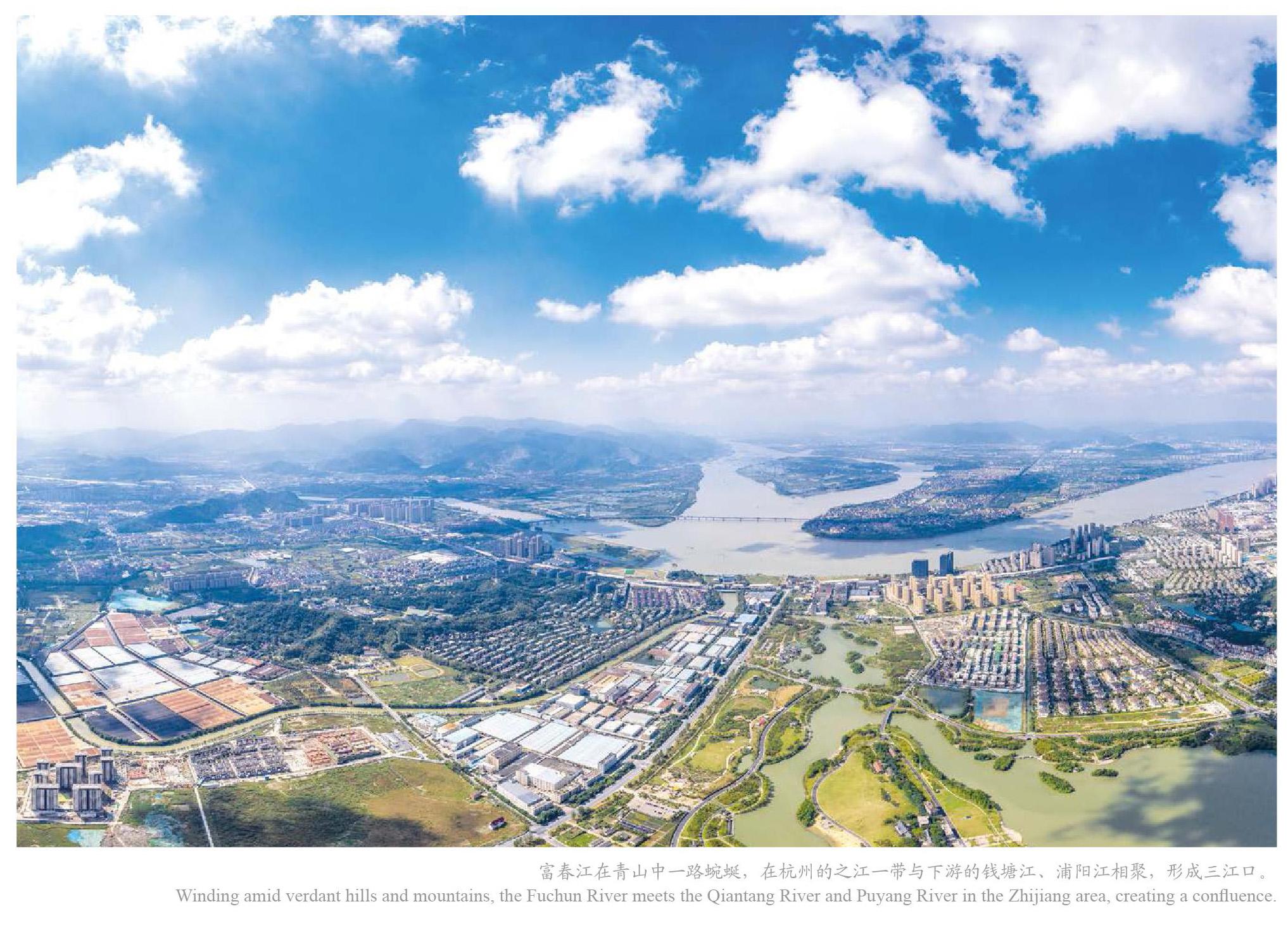艺术之花正绽放 生动画卷现长廊
2021-09-24金少策
金少策



沿着钱塘江一路往西,在钱塘江和富春江交界之处,有一片极长的沿江岸线,这一片直接面江的区域,就是之江地区。
之江地区,不单单是指之江国家旅游度假区,还包括转塘、双浦等。其西面和富阳依水相邻,东面又和滨江、萧山隔江相望,在沿江的岸线里,之江地区刚好是在中间位置。
这里是浙江省精心打造之江艺术长廊的重要阵地。浙江省委文化工作会议提出,要深化文化建设“八项工程”,深入推进新时代文化浙江工程,培育浙江文化新标识,构建文化建设大平台,形成文化发展新格局。早在今年6月底,浙江省委召开主题新闻发布会,宣布精心打造之江艺术长廊,首批入选项目包括良渚古城遗址公园、国家版本馆杭州分馆、中国美术学院、浙江音乐学院、南宋皇城遗址、中国历代绘画大系编辑中心、浙江美术馆、中国丝绸博物馆、之江编剧村、网络作家村等。同时,相关规划也被列入同期发布的《浙江高质量发展建设共同富裕示范区实施方案(2021-2025年)》。
软实力迭代升级的重要举措
透视浙江发展奇迹,文化发展深蕴其中,文化建设更是成为浙江发展中格外耀眼的篇章。
2003年,“进一步发挥浙江的人文优势,积极推进科教兴省、人才强省,加快建设文化大省”被写入“八八战略”。18年来,浙江聚焦文化的力量,从建设文化大省、文化强省到文化浙江,文化软实力日益彰显。
此次之江艺术长廊建设,是浙江省落实“八八战略”、发挥人文优势、建设文化大省,聚力“重要窗口”建设、“共同富裕示范区”建设、实现从文化大省到文化强省的飞跃、实现文化软实力迭代升级的重要举措。
之江艺术长廊也是新时代新征程对浙江的召唤。建设之江艺术长廊,一要聚焦“重要窗口”“共同富裕示范区”,打造无愧于时代的精品,汇聚全球艺术精英人才;二要进一步彰显中国文化软实力,体现中国味,充分发挥长廊优势,点面结合、优势共组,争创一流、走向国际;三要扬长板、补短板,以提升浙江文化整体实力为目标,按照中国所需、浙江所能、群众所盼、未来所向进行谋划;四要立足新时代,努力打造新時代“富春山居图”;五要让人民群众有获得感,建设“共同富裕示范区”需文化先行,最终提升浙江人民的整体文明程度。
左手科技、右手艺术,之江艺术长廊和杭州城西科创大走廊一样,成为浙江省的重大战略决策,对标国际一流、集全省之力将其建设成为面向世界、引领未来、服务全国、带动全省的创新策源地。
杭州城西科创大走廊启动建设以来,实现了高质量、高速度的跨越式发展:产业增加值年均增长22.1%,高科技技术产业增加值年均增长21.9%,数字经济核心产业增加值占全省四分之一。
作为经济新增长点的文化产业,有着同样的社会经济基础。2020年上半年,杭州文化产业增加值实现2285亿元,比上年增长8.2%。特别是艺术产业发展实现逆势上扬,成为全市文化产业发展的鲜明特点和重要增长点。此外,重点平台项目建设步伐也在不断加快,成为引领产业向好发展的重要力量。
值得期待的是,之江艺术长廊将大大提升浙江文化软实力,有望与四条诗路文化带、杭州城西科创大走廊交相辉映,呈现出一幅科学与艺术在“浙”里重逢的崭新画卷。
建筑和艺术融合的自然美学
建筑已成为人类生活中不可或缺的一部分,之江艺术长廊中的中国美术学院和浙江音乐学院等,将建筑和艺术有机结合,赋予了艺术长廊别样的内容。
中国美术学院象山校区周边环绕青山绿水,象山横亘于校园中部,被建筑与道路包围。新建一期工程由普利策奖获得者王澍教授主持设计,校区总体规划特别注重意境营造和生态保护,借鉴中西方大学校园的规划模式,建造一处分区明确,融建筑、空间、景观、自然于一体并且游与学共生的园林式、开放式的校园环境。场地规划从原有地势和环境特点出发,围绕山与水打造“图底关系”(设计不只是将研究对象专注于建筑本身,还包括它所占据的场所与空间),简洁明快、依势而为等风格凸显了建筑与环境、人与自然的交互关系。
在校园中我们可以见到许多横跨、穿梭、附着于建筑、水域、山体间的廊道和构筑物,如建筑外廊、跨河的走廊、水边小屋等,都是既可步行环游,又可作为交流、展示的场所,甚至是某种非常规的教室、会议室,它们连接着室内与室外、建筑与自然,使校园既是理想的教育场所,同时也成为城市的新文化景观。
远眺浙江美术馆,其轮廓线从东边的玉皇山逐层向西面降低,“仿佛从山上滚下的一块石头”,与西湖浑然一体。为了让美术馆的屋顶有江南传统坡顶的感觉,设计者程泰宁颇费了一番心思。“粉墙黛瓦,坡顶穿插,黑白构成,江南流韵”,这是基调。用钢、玻璃、石材的材质对比,方锥与水平体块的相互穿插,使建筑具有强烈的雕塑感。屋顶的每一块玻璃,都搭配一张设计图纸,以求装置严丝合缝。
在这座建筑前,仿佛所有自然景观与建筑物之间的矛盾元素都被“收编”了,有的只是“和谐”。中国国家大剧院设计者保罗 · 安德鲁由衷赞叹:“如果还有像浙江美术馆一样的建筑设计,请一定允许我参与。”
浙江音乐学院整个校园则依山傍江,状似一只蝴蝶,寓意“化蛹为蝶”。一条乐章大道,宛若五线谱,自西向东贯穿整个校园。16幢教学楼、校舍及办公楼好似音符,灵动跃然于乐谱间。
南宋皇城大遗址是南宋历史文化的象征,是杭州历史文化遗产的“制高点”。打响“南宋牌”,向世人展示中国最美丽山水花园式的皇城遗韵,是未来杭州的目标。
可以说,一个城市有没有特色,主要看城市空间布局、城市建筑风格、城市标志性建筑等非常直观的城市外在体现。建筑与艺术的融合,正如文化和生活的梦想。浙江音乐学院和中国美术学院象山校区的建筑美学给世人带来了视觉艺术享受,不仅对于建设之江艺术长廊有着引领意义,更满足社会、群众多层次的文化需求,具有重大意义。
这些建筑背后体现了可贵的文化自信和文化自觉,是对文化地位作用的深刻认识、对当代文化发展规律的正确把握、对发展文化历史责任的主动担当,体现了在推进之江艺术长廊建设中,以战略眼光和全局视野深刻把握打造新时代文化高地的新使命,体现了在共同富裕中实现精神富有,在现代化先行中实现文化先行,让文化成为“重要窗口”中最具魅力、最吸引人、最为靓丽的亮点。
串珠成鏈的艺术标杆
首批入选之江艺术长廊的项目,无一不是浙江文化领域的标杆之作。
良渚古城遗址公园是中国最大的史前城址之一,一直被誉为“中华第一城”。良渚古城遗址真实、完整地保存至今,可实证距今5000年前中国长江流域史前社会稻作农业发展的高度成就,填补《世界遗产名录》中东亚地区新石器时代考古遗址的空缺,为中国5000年文明史提供独特的见证。
国家版本馆杭州分馆建设,是国家从文化安全和文化复兴的战略考量出发作出的重大部署,是列入“十四五”规划的精品传世工程,是集展览馆、图书馆、档案馆、博物馆等多种功能形态于一体的综合性场馆。
国家版本馆中央总馆设于北京,3个分馆分别建在杭州、广州和西安。总馆、分馆共同承担中华文化基因种子库和版本资源灾备中心的重任。在杭州“十四五”规划中提到,建设国家版本馆杭州分馆是一个重大文化工程。
浙江音乐学院的前身是杭州师范大学音乐学院,是浙江省最早开设高等音乐教育的高校,被誉为全国最美的音乐学院。李叔同先生早年在这里从事学堂乐歌的写作和教学,学院也因此成为中国现代音乐教育的主要发源地之一。
南宋皇城遗址,是浙江历史上最重要的王朝都城。南宋皇城遗址位于杭州凤凰山东麓,是公元12—13世纪中国都城建设的杰出代表。南宋皇城内部分为宫城内和宫城外两个部分。宫城内殿、堂、楼阁约130余座,巍峨林立,光耀夺目。凤凰山御苑内保存大量的石刻遗迹,现拟辟为“南宋故宫遗址公园”。
由蔡元培先生于1928年创立的中国美术学院,是中国第一所综合性的国立高等艺术学府,也是联合国科教文组织唯一承认学历的中国美术类大学。近百年来人才辈出,林风眠、潘天寿、黄宾虹、赵无极等人都曾在这里播下艺术的种子。校区内建筑与山水之美浪漫交织,无处不流淌着艺术的气息。
得西子之灵秀,集玉皇之雄浑。一个个文化名迹正通过之江艺术长廊规划建设串珠成链,为正在兴建的之江艺术长廊安插上一对飞速发展的“翅膀”。在它们的辐射效应之下,以艺术文化为代表的创意产业也正快速在此集结,之江的人文艺术氛围将愈来愈浓。
艺术提升生活品质
之江艺术长廊将增强浙江人民的审美韵味、文化品位,让艺术成果更多地服务于人民群众的高品质生活需求。
中国美术学院院长高世名从“大之江”“大艺术”的维度提出,要将之江艺术长廊打造为全球最大艺术教育社区、全国最强数字文化航母、全民共享艺术生活家园,为之江地区乃至杭州带来更多的时尚和人气。
2007年,中国美院象山校区建成开学,大量艺术人士开始在之江新城的转塘单元汇聚。原本质朴的小乡村,因为他们的到来,发生了惊人的改变。一马当先的,就是外桐坞村。
裘阿姨是“外桐坞艺术村壹号画室”的房东。她家的二层小楼,即将租给一位新房客——中国美院油画系的一位毕业生。当地的村民,也将自己家的房子改造成了艺术工作室,租给美院的学生。村里两个茶叶加工厂和村委会的旧址也被改成了艺术会所,目前已经有20余位艺术家选择在外桐坞村开设绘画、雕塑工作室。
在风景秀美的杭州西溪湿地内,有一个建筑面积超2500平方米、拥有2000平方米大草坪的“村”,云集了一批声名赫赫的编剧。这个深藏不露的“村”,就是之江编剧村。
走过编剧村长长的回廊,透过落地窗看去,映入眼帘的是郁郁葱葱、水草丰茂的湿地美景。据了解,编剧村在总体氛围营造布设中,充分融入李渔代表作《闲情偶寄》元素,努力构建编剧创作与环境共融的理想空间。这样优美的环境,更容易激发编剧们的创作灵感。
不少编剧界大腕已经被吸引过来。据了解,之江编剧村目前邀请了《雍正王朝》《北平无战事》编剧刘和平担任名誉村长,由马继红、王宛平、刘毅、程蔚东、兰晓龙、黄亚洲、麦家等著名编剧担任创作导师。
培育青年编剧、电影人,是编剧村的重点任务。编剧村定期邀请业内知名编剧,举办编剧大师创作论坛、编剧沙龙、剧本征集、编剧训练营等活动,为青年编剧、电影人提供常态化的业务能力提升渠道。
目前,运营团队还在构建剧本评估体系,邀请国内一流编剧进行定向指导,推动影视剧本创作精品化。同时,探索开展浙江大学专业研究生教育及浙江大学继续教育、非学历教育等,推动建设学历与非学历人才培育基地。
Zhijiang Art Corridor: A Perfect Blend of Art, Culture and Architecture
By Jin Shaoce
All the way to the west along the Qiantang River, where it meets the Fuchun River, lies a long strip of land directly looking at the rivers. This piece of land is known as the Zhijiang area. The Zhijiang area not only refers to the Zhijiang National Tourism Resort, it also includes places such as Zhuantang and Shuangpu. On the west, it is adjacent to the Fuyang district by the river, and on the east, it faces the districts of Binjiang and Xiaoshan across the river.
Sitting right in the middle, the Zhijiang area has naturally become the focal point for the Zhijiang Art Corridor, and the plan to establish the corridor was announced at a recent press conference themed “Preserving Partys ‘Red Roots and Making Zhejiang ‘an Important Window of China” and held by the Communist Party of China (CPC) Zhejiang Provincial Committee. The first batch of projects selected for the corridor include the Archeological Ruins of Liangzhu City, the China National Archival Library of Publications (Hangzhou Center), the China Academy of Art, the Zhejiang Conservatory of Music, the Zhijiang Cultural Industry Belt, the Southern Song Dynasty Imperial City Ruins, the Editorial Center of the Series of Ancient Chinese Paintings, the Zhejiang Art Museum, the China National Silk Museum, the Zhijiang Screenwriters Village, the China Internet Writers Village, among others.
Meanwhile, the plan has been written into the newly published Roadmap to Build Zhejiang into a Demonstration Zone for Common Prosperity through High-Quality Development. It is a continuation of the “Double-Eight Development Strategy”, which, published on August 8, 2003, has pointed out that “the cultural resources of Zhejiang should be fully tapped so as to build a culturally advanced province”. The establishment of the Zhijiang Art Corridor is a crucial step towards achieving the goal; it is also a response to the call of the new era: to realize common prosperity, it is imperative to focus first on cultural development.
Similar to the Hangzhou West Science and Technology Innovation Corridor, which is centered on science and technology innovation, the Zhijiang Art Corridor is just another major strategic decision made by Zhejiang province to drive cultural innovation. Since its launch four years ago, the Hangzhou West Science and Innovation Corridor has achieved high-quality and high-speed leapfrog development: average annual growth rate of industrial added value stands at 22.1%, average annual growth rate of high-tech industry at 21.9% and the added value of digital economy core industries accounts for one quarter of the provinces total. If the Science and Innovation Corridor is any indication, Zhjiang Art Corridor will become another driver for economic growth, supported by the robust development of cultural industry: in the first half of 2020, the added value of Hangzhous cultural industry reached 228.5 billion yuan, an increase of 8.2% over the previous year.
As an indispensable component of art, architecture is an essential part of many art projects and the unique charm of the Zhijiang Art Corridor can be found in the architectures of those sites which are located within.
Surrounded by green hills and clear waters, the Xiangshan campus of the China Academy of Art is thus called largely because the Xiangshan Mountain lies right in the middle of the campus. Overseen by Professor Wang Shu, the first Chinese citizen to win the Pritzker Prize, the worlds top prize in architecture, the overall planning of the campus is specially tailored for ecological protection, as well as creating an open, inviting and garden-like atmosphere. On the campus, many corridors or structures that stride, go through or are attached to buildings, waters and hillsides can be found, which serve not only as footpaths, but also as places for communication and exhibition or even as venues for classes and meetings.
Looked at from afar, the silhouette of Zhejiang Art Museum lowers from Yuhuang Mountain in the east layer by layer to the west, “as if a giant stone tumbling down”, blending eventually with the West Lake. Cheng Taining, designer of the museum, went to great lengths to make its roof look like a traditional Jiangnan (south of the Yangtze River) sloping roof. “White walls and black tiles, with a Jiangnan style” is the basis, and the use of steel, glass and stone materials and the interspersion of square cones and horizontal blocks lend the building a strong feel of sculpture. Paul Andreu, designer of National Center for the Performing Arts in Beijing, once said that if another architectural project like that of the Zhejiang Art Museum came up, he would definitely join.
The whole campus of Zhejiang Conservatory of Music, on the other hand, takes the shape of a butterfly, with the symbolic meaning of “breaking out of the cocoon and transforming into a butterfly”. An avenue of musical notes, resembling the staff, runs through the campus from west to east. The 16 teaching and office buildings as well as dormitories spread on the campus like musical notes on sheet music.
Underlying these remarkable architectural buildings is a sense of cultural confidence and cultural self-awareness, and, above all, a commitment to the historical responsibility of cultural development. Indeed, each and every project selected for the Zhijiang Art Corridor is a veritable cultural landmark.
The Archeological Ruins of Liangzhu City is one of Chinas largest prehistoric city sites, long hailed as the “First City of China”. It shows and testifies to the great achievement of prehistoric rice-cultivating civilization of Chinas over 5,000 years ago, and is an outstanding example of early urban civilization. The Southern Song Dynasty Imperial City Ruins, one of the most important capital cities in Zhejiangs history and throughout the Chinese history, reveals an imperial palace with over 130 halls and pavilions. A large number of stone carvings are well preserved in the former imperial garden on the Phoenix Mountain, which is expected to be turned into the Southern Song Dynasty Imperial Palace Heritage Park. As Zhejiangs oldest higher institution of music, the Zhejiang Conservatory of Music is one of the main cradles of modern music education in China, and the China Academy of Art has produced crops of top talent since its inception in 1928.
Ultimately, the aesthetic value of architectures and the cultural significance of these landmarks are meant to help improve the quality of life. Gao Shiming, president of the China Academy of Art, proposed to develop the Zhijiang Art Corridor into the largest community of art education in the world, in which every one is able to enjoy an artistic life. In fact, the Xiangshan campus of the China Academy of Art has already brought palpable changes to neighboring areas since its opening in 2007. A nearby village called Waitongwu village saw two of its tea processing plants repurposed and changed into art galleries, and over 20 artists have set up painting and sculpture studios here.
Another “village”, hidden within the Xixi National Wetland Park, is the newly launched Zhijiang Screenwriters Village. Quite a few heavyweights, including Liu Heping, best known for his historical works such as All Quiet in Peking, have already been attracted to the place, and will mentor young and aspiring screenwriters. Forums, workshops and training camps will be also held regularly for these screenwriters.
